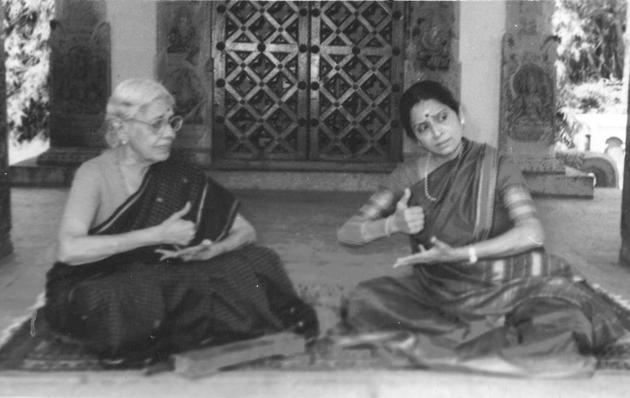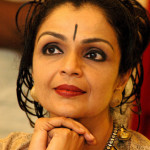
A photographic memory and compassion were the hallmarks of Periya Sarada teacher’s personality.
The image slowly pixelates on the mind screen. Like a million small pieces of information gleaned from memory, reflection, direct experience and nostalgia, each molecule falls into place on the large canvas of history. What we see is a giant portrait – of a savant, scholar, musician, student, life-long seeker, psychological salve, cultural archaeologist and a life-long loyalist to the cause of Theosophy and the vision of Kalakshetra.
S. Sarada, (Periya Sarada teacher -(1915-2015) was a shadow. Not invisible, but more like a clear silhouette, a visible presence whose mind proved a perfect catalyst to Rukmini Devi’s dazzling imagination. The founding of Kalakshetra in 1936 attracted many great minds – Tiger Varadachariar, Budalur Krishnamurthy Sastrigal, Mylapore Gowri Ammal, Mysore Vasudevachariar and Karaikudi Sambasiva Iyer. But one young woman became the pillar of the institution. She was 24 years old when she joined and became such an integral part of Kalakshetra that Rukmini Devi herself acknowledged that “Srimati S. Sarada is my right hand and a rare embodiment of knowledge, devotion and artistic ability.”
Born on September 1, 1915, in Thanjavur, Periya Sarada teacher was initiated into learning Sanskrit, Carnatic music – vocal and instrumental – and Advaita philosophy by her grandfather and parents. The density of the Yoga Vasishta, the sweep of Kalidasa’s writings and the commentaries of great teachers such as Sankara, Ramanuja and Madhava comprised her daily reading. Lightning struck when she watched Rukmini Devi at the Madras Music Academy’s general session in 1934. “I was stunned by her striking personality,” she confesses in her book, ‘Kalakshetra-Rumini Devi.’ She continues, “Rukmini Devi had come to witness a dance performance and I was watching Rukmini Devi.” The very next year, Rukmini Devi performed for the Diamond Jubilee of the Theosophical Society and S. Sarada’s initial fascination deepened.
Rukmini Devi’s charisma and demeanour created an aura that the young Sarada wanted to be close to. The opportunity came when her grandfather Pandit Subramania Sastri came to work at the Adyar Library in 1939. His grand daughter accompanied him and was suddenly thrust into the cosmopolitan society of Madras – the vibrant Theosophical movement.
When Rukmini Devi invited S. Sarada to attend one of her dance rehearsals in 1939, she was so inspired that she began writing down the notations for the choreography of the dance, ‘Ananda Natana Prakasam.’ Her knowledge of music and Sanskrit came to her aid while she wrote down each line of the choreography with meanings and the sketches of line drawings to reflect the choreography. Rukmini Devi was initially skeptical but looking at the exact notation of each swara and tala pattern that Sarada had painstakingly written down impressed her. The notation system is still followed in Kalakshetra.
With Rukmini Devi becoming increasingly busy with education, craft revival and attending the Rajya Sabha sessions in New Delhi, it was Periya Sarada teacher who conducted the long rehearsals in Kalakshetra, Chennai. The students and dancers looked forward to her keen eye and unflagging patience. A photographic memory and all encompassing compassion were the hallmarks of S. Sarada’s personality. She was the link between the text and the dancer. Every word, every line and every mood was explained in several ways to the eager students. Even the musicians were in awe of her knowledge. Her tiny room in Kalakshetra, next to Rukmini Devi’s, was always filled with her tiny frame and numerous books and papers. Students lined up to talk to her, ask questions and interpretations for some words in a particular dance. S. Sarada was also a fascinating story teller, who kept children glued under the Adyar banyan tree for hours while grateful parents completed their chores.
Looking back, one can confidently state that without the patient and dedicated erudition of S. Sarada, Rukmini Devi would have never been able to complete her iconic Ramayana Natya series. One image remains in my memory since 1973. A Post Graduate student at Kalakshetra, I was being taught by Neila Sathyalingam, Sarada Hoffman and N.S. Jayalakshmi. After class, we would all stagger out of the thatched huts and slowly make our way to the exit. Passing by the main theatre, some of us would stop silently and peer through the cane and bamboo divider. It was there that I saw Periya Sarada teacher seated, surrounded by books and papers, in Sanskrit and Tamil, strewn on her lap and her slender body leaning towards Rukmini Devi.
Through the trellis, I saw dancers Krishnaveni, Janardhanan, Kunhiraman and Balagopal standing quietly on stage, waiting for instructions. Atthai would tilt her head towards Periya Sarada teacher who would be pouring multiple interpretations of the Sanskrit text into Atthai’s fertile mind. At times, Atthai’s voice was sharp, almost a reprimand, but never did Periya Sarada teacher raise hers. When dancers were reduced to tears by some remark from Atthai, it was Sarada who applied the emotional salve to their young wounds. She was a life coach, helping students, guiding the teachers, creating the teaching syllabus, drafting the classes for dance theory and history and being the ‘asthana vidwan’ under the banyan tree.
How could such a slender frame accommodate so much brilliance? How could her patience and energy never flag for decades?
Periya Sarada teacher could explain each word or line of a poetic text from the Gita Govindam or a rare Tamil kriti for hours. She could provide endless explanations for each word, thus opening up the possibilities of young minds that flocked to her after class hours. Her hour-long explanation in one of my classes (a surprise rare visit) on the first line of the iconic varnam ‘Roopamu Joochi’ is indelibly etched in my mind. Even today I remember her slender fingers opening out into an ‘alapadma’ to depict the idea of beauty and grace!
Erudition, patience, dedication, compassion, humility, fierce focus and endless thirst for knowledge – these were the words that appeared and re-appeared in the various articles that I edited for the volume ‘Nirmalam’ on her 90th birthday in 2005. Every writer, Yamini Krishnamurthy, C.V. Chandrasekhar, Dhananjayans, Janardhanan, Katherine Kunhiraman, Leela Samson, C.K. Balagopal and others stressed that Kalakshetra’s choreographic treasures would never have been created and preserved without Periya Sarada’s meticulous notations and enormous generosity towards Rukmini Devi’s vision for the arts.
My time in Kalakshetra was brief and although I was interested in dance theory and international dance history (I was already an English Literature Graduate from Madras University), I never got a chance to study under Periya Sarada teacher. She was already steeped in the research and creation of the Dasavatara Natya series for Kalakshetra. She did, however, find the time to read my papers which were forwarded to her by Neila Sathyalingam. She added her appreciation on the pages in her neat flawless writing. She also attended two of my performances – in 1978 and 1996. On both occasions, she came back stage, embraced me and stroked my face saying, “Your abhinaya is very good.”
In 1985, Sarada teacher was cruelly dismissed from service during the Government of India take over of Kalakshetra. Devoid of pension, retirement income or any means of existence, she was nurtured until her last days by her faithful companion and friend since 1939 – G. Sundari.
The technology of the present day – You Tube, Instagram, live streaming, Facebook – while distracting – may have kept her legacy and thoughts alive in multiple ways.
Today, her contribution remains a gentle memory for those who were fortunate to study and catch a sliver of her fecund mind.
In her final days, she sat silent and listless on her wheel chair, gazing into the green vistas of the Theosophical Society which was her home. Dimmed eyesight, a saddened spirit and almost forgotten by the new generation of students and teachers in Kalakshetra, Periya Sarada teacher held her disappointment and ache within her frail body. As much as she adored and admired Rukmini Devi’s pioneering vision for the arts, Sarada was estranged from her idol when she was one of the signatories who aligned against Atthai in a legal issue. S. Sarada maintained that the institution was always larger than the individual. Towards the end of her days, Rukmini Devi and S. Sarada settled their differences but this chasm was heard like a thunderbolt throughout the dance world and stunned all of us.
Her passing on November 4, 2009, was akin to the felling of an ageless tree. In knowledge Periya Sarada teacher gave shade like a Banyan, in scholarship she towered above all like a Redwood and in grace she healed like a Neem.
Her final breath came amidst the verdant Theosophical Society, whose most devout student has left generations of dance and music students enriched and blessed with her singular personality.
September 1 marks the birth centenary of Periya Saradha teacher. The students of Kalakshetra will present a special musical homage at Rukmini Arangham, 6.30 p.m.

Photo: R. Shivaji Rao
(The writer, performer-arts entrepreneur, The writer was a Kalakshetra student. She has published a book on S. Sarada’s life. She may be contacted at anitaratnam@yahoo.com; @aratnam)
source: http://www.thehindu.com / The Hindu / Home> Features> Friday Review> Dance / by Anita Ratnam / August 27th, 2015